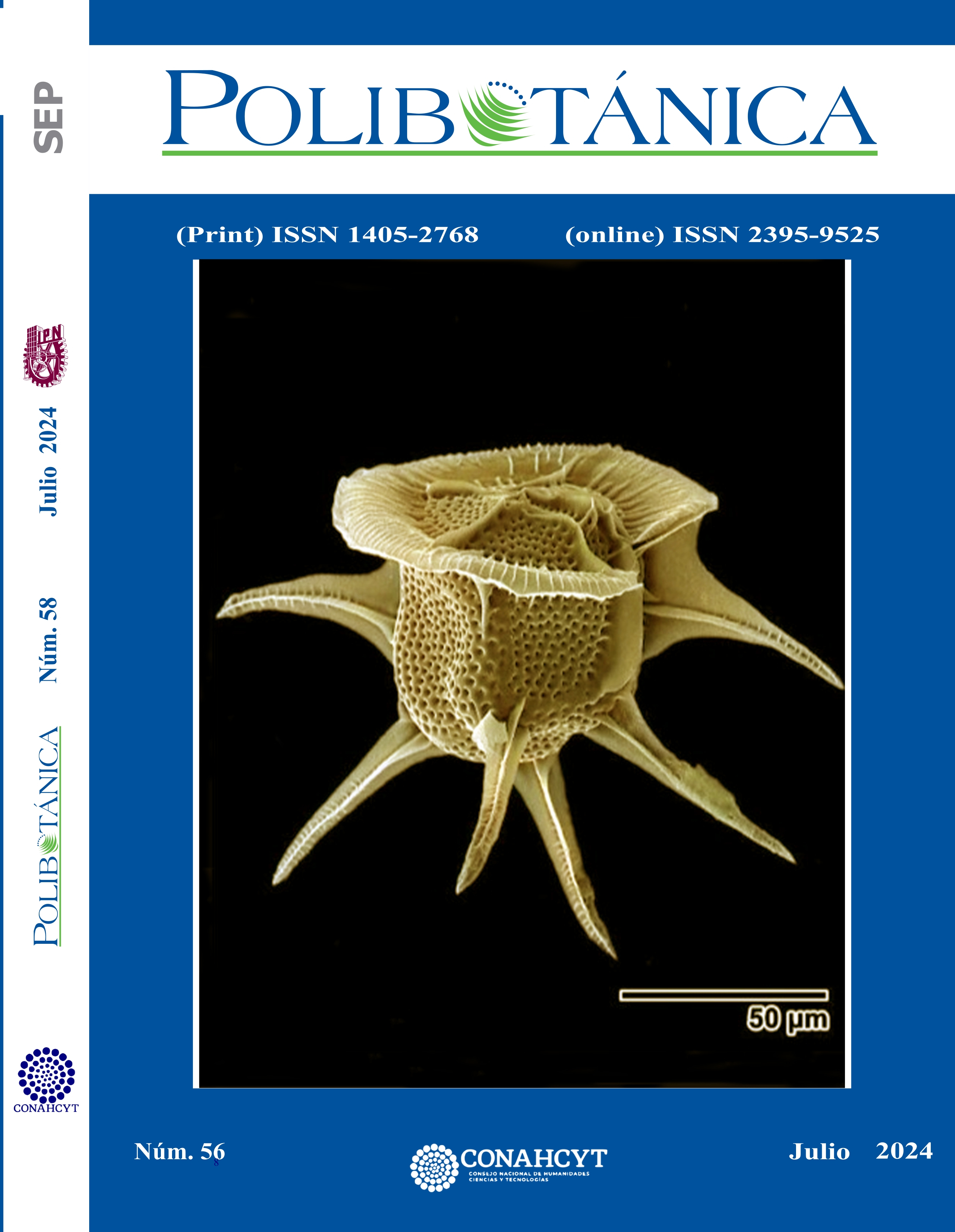Vegetation diversity through a humidity gradient of San Ignacio Oasis, Baja California Sur, Mexico
DOI:
https://doi.org/10.18387/polibotanica.58.8Keywords:
Species diversity, desert, dendrogram, Shannon index, Simpson index, Sorensen index.Abstract
Soil humidity is an important environmental factor that affect composition, diversity and structure of the vegetal communities. The objective of the present study was to determine the diversity changes that occur over a humidity gradient, limited by the source of water of the oasis San Ignacio and the adjoining desert of Baja California Sur, Mexico. The study area was divided into nine strips of 100 m width. Over them, there were randomly selected 140 plots of 500, 20 and 1 m2 to register the vegetal species present in the tree, shrub and herbaceous layers, respectively. Species richness, Shannon-Weiner diversity, Simpson dominance, Pielou equity and true species value indexes were estimated and compared between humidity levels. The qualitative index of Sörensen was estimated to evaluate species similitude and similar communities were grouped applying dendrograms. The species richness of the herbaceous and shrub layers falls abruptly at 520 and 720 m far away from the source of water. Species richness and diversity in the tree layer presented an undefined tendency. The similitude index allowed to concentrate the herbaceous, shrub and tree vegetation layers in 4, 5 and 3 clusters. The diversity analysis suggest to determine that herbaceous and shrub species are more sensitive to humidity changes than tree species.
References
Austin, M. 2002. Spatial prediction of species distribution: an interface between ecological theory and statistical modelling. Ecological Modelling 157, 101-118. https://doi.org.10.1016/S0304-3800(02)00205-3
Breceda, A., Tenza-Peral, A., Giménez-Casalduero, A., Cariño-Olvera, M. & Echeverria-Ayala, Y. 2020. En Ortega-Rubio, A. (Ed), Socio-ecologycal Studies in Natural Protected Areas, Linking Community Develpment and Conservation in Mexico, (pags. 425-439), Springer Nature, Switzerland. https://doi.org/10.1007/978-3-030-47264-1
Cariño-Olvera, M. M. & Monteforte-Sánchez, M. (2018). La Historiografía ambiental sudcaliforniana y la sustentabilidad local. Historia Ambiental Latinoamericana y Caribeña Revista de La Solcha 8(2), 14-41. Doi: https://doi.org/10.32991/2237-2717.2018v8i2.p14-41
Chaturvedi, R. K. & Roghubanshi, A. S. (2018). Effects of soil moisture on composition and diversity of trees in tropical dry forest. MOJ Ecology and Environmental Science 3(1), 1-3. Doi: https://doi.org/10.15406/mojes.2018.03.00059
Coldwell, R. K. (2013). EstimateS: Statistical estimation of species richness and shared species from samples. Version 9. User´s Guide and Application. Disponible en: http://purl.oclc.org/estimates
CONAGUA. (2015). Atlas del Agua en México. Secretaría de Medio Ambiente y Recursos Naturales, Comisión Nacional del Agua, México Disponible en: http://www.conagua.gob.mx/CONAGUA07/Publicaciones/Publicaciones/ATLAS2015.pdf
Courtwright, J. & Findlay, S. E. G. (2011). Effects of Microtopography on Hydrology, Physicochemistry, and Vegetation in a Tidal Swamp of the Hudson River. Wetlands 31, 239. Doi: https://doi.org/10.1007/s13157-011-0156-9
Diaz, S. & Troyo, E. (1997). Balance hidrológico y análisis de la aridez. En: Arriaga, L., & Rodríguez, E. R. (Ed.). Los oasis de la Península de Baja California. Centro de Investigaciones Biológicas del Noroeste, S. C., La Paz Baja California Sur, México, 35-49. Disponible en: http://dspace.cibnor.mx:8080/handle/123456789/2942
Garcia, E. 2004. Modificaciones al sistema de clasificación climática de Köppen. Instituto de Geografía, Universidad Autónoma de México, 5ª. Edición, 1-90. Disponible en: http://www.publicaciones.igg.unam.mx/index.php/ig/catalog/view/83/82/251-1
INEGI. (2013). Conjunto de datos vectoriales de uso de suelo y vegetación escala 1:250,000. Recuperado de: http://www.conabio.gob.mx/informacion/gis/
López-Fuentes, F. O. (2019). α-Diversidad de diatomeas epilíticas del Oasis San Ignacio Baja California Sur, México. CICIMAR Oceánides, 24(2), 101-110. Disponibe en: https://oceanides.ipn.mx/index.php/cicimaroceanides/article/view/59/54
Mitsch, W. J., & Gosselink, J. G. (2007). Wetlands. New York, USA: John Wiley and Sons.
Hammer, Ø. (2022). Paleontological Statistics Version 4.09 Reference Manual. Natural History Museum, University of Oslo. 1-296
Olthoff, A. E., Martínez-Ruiz, C., Alday, J. G. (2016). Patrones de distribución de especies arbustivas respecto a arbóreas a lo largo de un gradiente ambiental atlántico-mediterráneo: una aproximación a partir de datos del tercer Inventario Forestal Nacional. Ecosistemas 25(3): 22-34. Doi: https://10.7818/ECOS.2016.25-3.03
Schleuter, D., Daufresne, M., Massol, F., Argiller, C. (2010). A user´s guide diversity indices. Ecological Monographs 80(3), 469-484. Doi: https://10.2307/20787442
Sheil, D. (1999). Tropical forest diversity, environmental change and species augmentation: after intermediate disturbance hypothesis. Journal of Vegetation Science 10(6), 851-860. Doi: https://doi.org/10.2307/3237310
Token, S., Jiang., Zhang, L., Lv, G. (2022). Effects of plant diversity on primary productivity and community stability along soil water and salinity gradients. Global Ecology and Conservation 36, 1-11. Doi: https://10.1016/j.gecco.2022.e02095
Wang, H., Lü, G., Zhou, Y. & Cao, J. (2017). Effects of functional diversity and functional redundancy on the stability of desert plant communities under different water and salt gradients. Journal Ecology 37(23), 171-180. Doi: https://doi.org/10.5846/stxb201610192139
Wheeler, B. D., Money, R. P., Shaw, S. C., Perrow, M. R., & Davy A. J. (2002). Freshwater Wetlands. In M. R. Perrow & A. J. Davy (Eds.), Handbook of Ecological Restoration (Vol. 2) (pp. 325-354). Cambridge, United Kindong, Cambridge University Press.
Yao, S., Akram, M. A., Hu, W., Sun, Y., Sun, Y., Deng, Y., Ran, J. & Deng, J. (2021). Effects of water and energy on plant diversity along the aridity gradient across dryland in China. Plants 10(4). Doi: https://doi.org/10.3390/plants10040636
Zhang, X., Yang, X., Lü, G. (2016). Diversity patterns and response mechanisms of desert plants to the soil environment along soil water and salinity gradients. Acta Ecológica Sinica 36(11), 3206-3215.
Zeng Y., Zhao, C., Kundzewicz, Z. W. & Lv, G. (2020) Distribution pattern of Tugai forests species diversity and their relationship to environmental factors in an arid area of China. PLoS ONE 15(5), 1-17. Doi: https://doi.org/10.1371/journal. pone.0232907
Downloads
Published
Issue
Section
License

Polibotánica by Departamento de Botánica de la Escuela Nacional de Ciencias Biológicas del Instituto Politécnico Nacional se distribuye bajo una Licencia Creative Commons Atribución-NoComercial-CompartirIgual 4.0 Internacional.




















